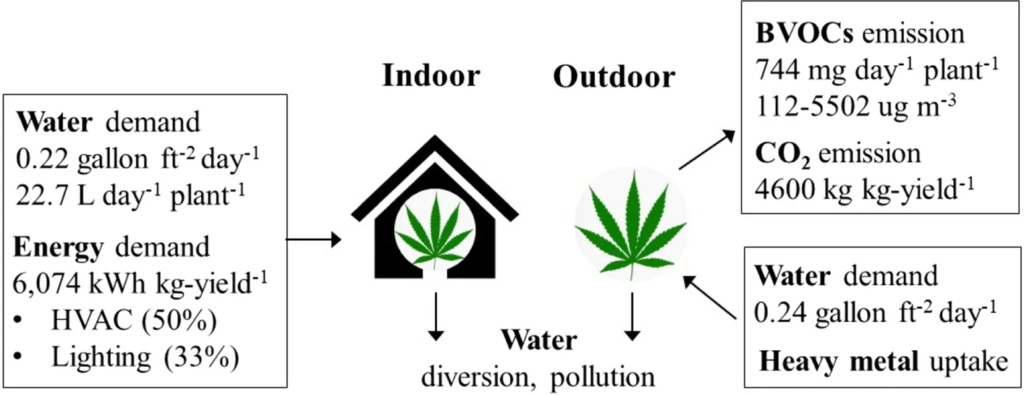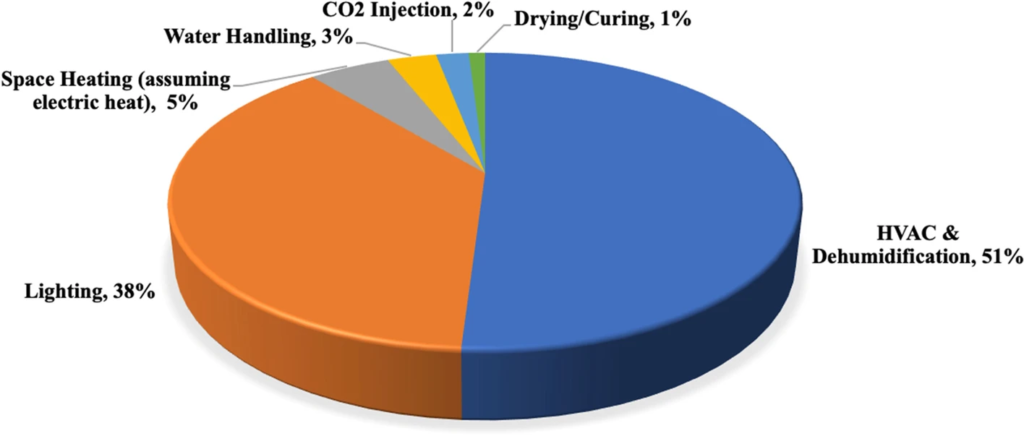|
|
The boom in the cannabis industry comes with an environmental impact. Cultivating cannabis uses up massive energy, water, and produces waste and strong odors.
Some of the big challenges in making this industry sustainable include rules and restrictions that limit our ability to research and learn more about these effects.
However, there’s some hope. The industry is exploring smaller, eco-friendly farming methods, energy-efficient lighting, water-saving systems, odor control, and waste reduction techniques, which we’ll cover in the following sections.
Environmental Impact of Cannabis Production
While it’s a booming industry, the cannabis production process isn’t without its environmental concerns. It consumes large amounts of energy and water, emits odorous gasses, and generates significant waste.
From an energy standpoint, cannabis is often grown indoors, requiring large amounts of electricity for lighting, temperature control, and ventilation.
Water usage is also substantial, particularly in dry regions with scarce water resources.
The process also creates strong odors that can disturb neighboring communities.
Lastly, cannabis production leaves behind a trail of waste – from plant material to consumer packaging, the industry’s waste footprint is substantial.
However, research into the environmental impact of this industry is still in its infancy due largely to restrictions on cannabis-related research.

Research Limitations in Cannabis Sustainability
Despite the cannabis industry’s considerable growth, there’s a significant lack of research into its environmental impact and sustainability practices due to federal restrictions. This limitation presents a significant hurdle as the industry seeks to understand and improve its environmental footprint.
Here are some areas where research is impeded:
- Energy consumption in cannabis cultivation
- Water use in cannabis farming
- Air pollution from the cannabis industry
Sustainability Issues in Cannabis
In addition to limited research, the cannabis industry’s sustainability efforts are also hampered by legal restrictions, environmental impacts of cultivation and transportation, excessive energy consumption, soil degradation, and water pollution.
It’s a tough balancing act. On one side, you have the laws that restrict cannabis growth and transport, creating a maze of touchpoints that hike up the industry’s carbon footprint. On the other, there’s the heavy energy toll taken by indoor cultivation facilities.
And let’s not forget the soil erosion and water pollution resulting from traditional farming practices. All these factors combine to form a formidable barrier to sustainability.
Transportation Challenges in Cannabis
Transportation challenges further complicate the sustainability efforts in this sector. Here’s how:
Legal Restrictions
Laws at the federal and state levels often limit transportation routes, forcing cannabis to travel long distances, increasing fuel consumption and emissions.
Multiple Touchpoints
Cannabis product often passes through various intermediaries before reaching consumers, each step adding to the carbon footprint.
Lack of Direct Pathways
The absence of direct routes to consumers compounds the issue, necessitating longer travel distances and contributing to air pollution.
These challenges underscore the need for policy changes and innovative solutions to make cannabis delivery and transportation more sustainable.
Sustainable Practices in Cannabis Production
The cannabis industry is addressing its environmental footprint by innovating production methods that focus on energy efficiency, water conservation, odor control, and waste reduction.
Key methods include:
- Transition to energy-efficient LED lighting
- Adoption of water-saving irrigation techniques
- Use of innovative technologies such as ozone to reduce harmful air emissions and odor
- Implementation of recycling and sustainable packaging
Energy Consumption in the Cannabis Industry

Energy consumption in the cannabis industry is a significant environmental concern, as the indoor facilities often require high-intensity lighting, temperature control, and ventilation systems. To keep plants thriving, these systems run nearly constantly, leading to substantial energy use.
LED lighting is one way the industry is working to reduce its energy footprint. These lights consume less power and have a longer lifespan than traditional bulbs. Some cannabis producers, like Colorado’s Native Roots, have even swapped out old bulbs for LEDs.
In addition, new regulations in some areas are setting standards for energy usage in cannabis facilities. This has encouraged many growers to seek out energy-efficient solutions, helping to drive the industry towards more sustainable practices overall.
Transition to Greenhouse Cultivation
Greenhouses allow growers to utilize natural sunlight, reducing the need for energy-intensive indoor lighting. In addition, greenhouses offer:
- Higher control over climatic conditions, ensuring optimal plant growth
- The ability to grow year-round, increasing productivity
- Reduced water usage through efficient irrigation systems
Transitioning to greenhouse cultivation isn’t without challenges. Growers need to adapt their cultivation techniques and navigate regulations that may not fully support this transition yet.
Soil and Water Pollution in Cannabis Farming
Another significant environmental concern in the cannabis industry is the pollution of soil and water due to conventional farming practices. Heavy use of chemical fertilizers and pesticides can contaminate soil and water resources, posing a risk to local ecosystems.
Furthermore, the high water demand of cannabis plants can strain local water supplies, particularly in drought-prone areas. Erosion and nutrient loss from over-farmed soils can also be problematic.
However, sustainable farming methods, like organic cultivation and the use of automated irrigation systems, can help mitigate these issues.
Water Conservation in Cannabis Cultivation
Cannabis plants require large amounts of water for their growth. However, with the right strategies, the industry can significantly reduce its water footprint.
- Rainwater Harvesting: Collecting and storing rainwater provides a renewable water source, reducing reliance on municipal supplies.
- Drip Irrigation: This method delivers water directly to the plant roots, minimizing waste.
- Recycling Wastewater: Advanced filtration systems can clean and reuse water, reducing overall consumption.
With proper implementation, these measures can make a significant impact on water conservation.
Mitigating Odor Emissions in Cannabis
The odor emissions from cannabis aren’t solely due to terpenes, but also organosulfur compounds called thiols.
Several innovative odor control technologies are currently being employed in the cannabis industry to effectively manage the strong odors associated with cultivation. These methods prioritize efficiency, sustainability, and compliance with local regulations.
- Carbon filtration systems: These systems capture odorous compounds through adsorption, reducing the overall smell. They are a common choice due to their effectiveness and affordability.
- Dry vapor-phase technology: This technology neutralizes odors by releasing a waterless vapor that interacts with the odorous compounds. It’s often combined with carbon filtration for a more comprehensive odor control solution.
These technologies, while different, offer a significant step towards a more sustainable and less disruptive cannabis industry.
The Role of Ozone Technology in Cannabis Cultivation

The introduction of ozone technology in cannabis cultivation is emerging as a promising solution to some of the industry’s sustainability challenges. This technology helps with:
- Pathogen control: As a powerful oxidizing agent, ozone effectively eliminates bacteria, viruses, and fungi in the air and water, creating a hygienic environment, reducing the risk of disease, and enhancing crop health.
- Odor control: The pungent smell from cannabis cultivation is a nuisance. Ozone technology helps to neutralize these odors, ensuring a more comfortable working environment.
The Cannabis Industry’s Waste Problem
Compounding the environmental challenges facing the cannabis industry is the mounting waste problem, particularly resulting from single-use plastics and chemical waste.
- Overuse of Plastics: Regulatory requirements often lead to excessive packaging, resulting in a sea of discarded single-use plastics. Each product’s journey from grower to consumer leaves behind a trail of plastic waste.
- Chemical Contamination: Fertilizers and pesticides used in cannabis cultivation can contaminate soil and waterways, creating long-term environmental damage.
- Waste Disposal: Post-harvest waste disposal is a significant challenge. Often, byproducts aren’t composted or recycled due to strict regulations, contributing to growing landfill piles.
Waste Management in the Cannabis Industry
Many states in the US have begun loosening regulations to permit recycling of packaging and composting of plant debris. However, the process isn’t straightforward.
Disposing of cannabis waste is regulated by stringent rules, often requiring the waste to be mixed with non-cannabis waste before it can be composted.
In addition, the packaging used for cannabis products is often excessive due to child safety regulations, leading to an abundance of plastic and cardboard waste.
Some companies have initiated recycling programs, but overall, there’s still much work to be done to fully address waste management within the cannabis industry.
Packaging Challenges in Cannabis Industry
Faced with a myriad of rules that vary by state, businesses often produce excessive packaging to comply with child-resistant and tamper-evident requirements. This over-packaging results in a significant waste problem.
For instance, product labels must be large enough to accommodate all mandated data, causing containers to increase in size.
On the other hand, some states are making efforts to address this issue. Colorado, for example, recently revised its regulations to allow dispensaries to collect packaging waste for recycling and reuse.
Still, achieving sustainable packaging solutions remains a challenging endeavor in the cannabis industry.
The Role of Regenerative Farming Practices
Regenerative farming focuses on enriching soil quality, promoting biodiversity, and enhancing crop yields. Additionally, strengthening the soil’s ecosystem reduces the dependency on artificial fertilizers and harsh pesticides, promoting less chemical waste.
This sustainable farming method prevents nutrient loss and increases the soil’s natural ability to support plant growth. It also aids in water retention, reducing the risk of water pollution from runoff.
In Summary
The cannabis industry has a substantial environmental impact due to its intensive energy consumption, water use, odor emissions, and waste production. Overcoming legal and regulatory barriers is critical for further development in sustainable practices.
While it presents challenges, the industry is also exploring various sustainable methods like transitioning to greenhouse cultivation, LED lighting, water conservation techniques, and regenerative farming practices.
Innovative solutions such as ozone technology and odor control technologies are also making strides in mitigating the effects.
Though the road to cannabis sustainability may be difficult, these strategies offer an encouraging glimpse into a potential future of ecologically responsible cannabis cultivation and usage.
Sources:
https://cen.acs.org/environment/Cannabis-industry-inches-toward-sustainability/100/i30
https://jcannabisresearch.biomedcentral.com/articles/10.1186/s42238-021-00090-0
https://crc.berkeley.edu/wp-content/uploads/2020/12/CRC_Brief_WaterUse_2020_1205.pdf
https://www.ncbi.nlm.nih.gov/pmc/articles/PMC9236214/
https://www.healthline.com/health/cannabis-packaging
https://www.forbes.com/sites/forbesbusinesscouncil/2021/02/02/sustainability-in-the-cannabis-industry-truly-going-green/?sh=303e7c5e249e
https://doi.org/10.1021/acs.estlett.0c00844












